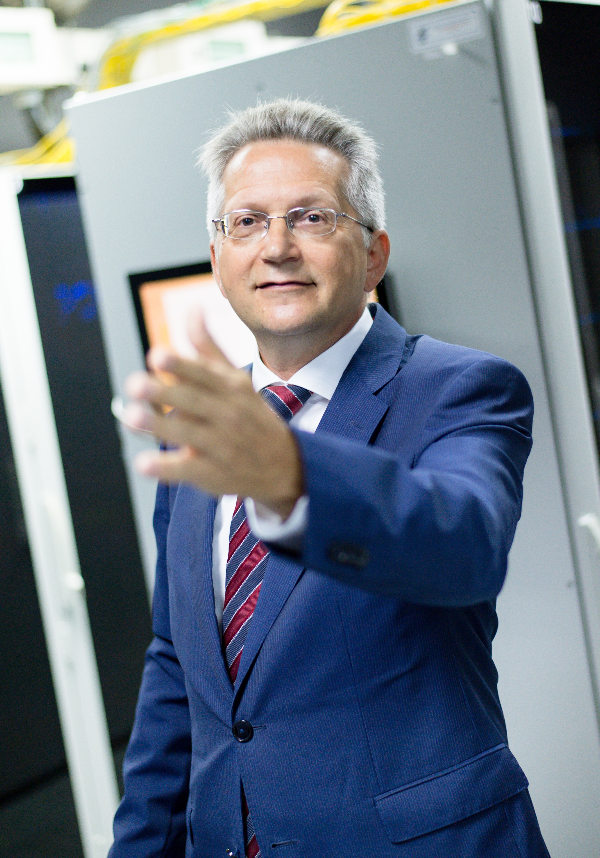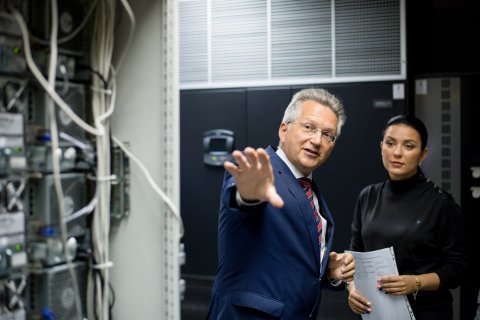Artificial intelligence will change all spheres of our lives. Not only the development prospects of the Russian Federation, but also the matters of national security are connected with it. No wonder that the developments in the field of artificial intelligence are a priority in Russia.
Profound research in this field is also being conducted in Chelyabinsk. Vice-Rector for Informatization of SUSU, Head of the Department of System Programming, Doctor of Sciences (Physics and Mathematics), Professor Leonid Sokolinsky has learned how to not only program artificial intelligence beautifully, but also to quickly put his mind in order. This all, thanks to the queen of sciences: Mathematics. Our conversation today is about the prospects of programming and the peculiarities of neural networks.

Photo: Leonid Sokolinsky
— What are you grateful to mathematics for? Does it help you both at work and in everyday life?
— Of course! When I was studying in my postgraduate studies programme in the field of Programming in Saint Petersburg, my academic advisor used to say: “Lyonya, you have a wonderful mathematical culture! It's not common with programmers”. This culture still helps me to write high-quality scientific articles, create programs, train postgraduate students in the spirit of respect for serious mathematics, teach them strict mathematical language, which helps word any concept formally and clearly.
Abstract strict mathematics brings mind in order very well, and develops logical thinking. If you combine the abstract thinking of a mathematician and the specific algorithmic thinking of a programmer, you will get a massive “reinforced-concrete” mix that is able to ram through any walls. But, sometimes other people see this mix as a too harsh one. Well, what can you do...it is what it is.
— What is the field of your scientific interests today?
— It is very broad. Mathematical programming, e-learning, parallel computing. And, of course, artificial intelligence: neural networks and their application.
— When creating artificial neural networks, do scientists act by touch, by trial and error?
— Scientists have been engaged in studying artificial neural networks for a very long time now, since late 50s and early 60s of the previous century. For a long period these scientific developments were of no use. There were no real specific fields of application. The biological basis is a very serious one; a model which greatly simplifies the human brain, but nevertheless, it is still a model of the brain of a human or other living being. The structure of neurons is the same for everyone.
The brain of a sparrow, for example, is also super powerful. It could seem that it is just a tiny object able to fit at the bottom of a thimble, but look what complex tasks it can perform! Flying, for example. How it behaves, searches for food, rescues from cats...One cannot program a sparrow robot that could perform all these things. It is impossible to do. Even now, when we have super powerful computers and systems. Moreover, we cannot even model a bee yet. So, the potential of artificial neural networks is very powerful. And scientists understand this.
— Can a neural network learn by itself?
— It can. There are such neural network models, but their scope of application is very limited. In most cases, the network cannot learn by itself. We need to program it by providing some samples.
— Is it true that its self-learning scares scientists?
— No, it is not. Scientists would only be happy about it.
— But it is not clear what it can learn by itself...
— This is what scientists are working on. The thing is if we take a certain task and ready-to-use samples, we can reduce the learning process to an acceptable time interval. And how long does it take a person to learn? All life. Accordingly, the mechanism of self-learning is associated with the feedback from the environment. That is, the neural network must conditionally interact with the environment, which, roughly speaking, will slap it on the fingers with a ruler if the answer is incorrect. This is difficult to implement, because the artificial neural network does not have fingers.
— Scientists also state that neural networks are, so to say, always not in the right mood…
— No. It is a computer model, after all, which is made according to certain rules and is not subject to any emotions. The truth is different and crucial. Scientists still do not understand how neural networks are actually trained. The algorithm is known, but why does it lead to a specific result?.. This deep mechanism of the brain model is not clear. And that's the problem. So, we cannot guarantee the error-free operation of neural networks.
Meanwhile, the progress in almost all spheres of human activity is associated with this powerful tool. Today, artificial neural networks are the mainstream in information technology, including in artificial intelligence. And they already yield amazing results. Cars are driving on their own, it’s fantastic!
— In the long run, there will be other difficulties. Who would such a car run over in a critical situation if there is a choice of the victim?
— That is the bottom line. On the one hand, modern artificial intelligence, neural networks plus our computer capabilities are a powerful tool that solves major problems. But on the other hand, we can never guarantee that the network won't start making mistakes. For example, how can we entrust the control of an aircraft to an artificial neural network in the future (and this will become possible already in our lifetime)? Now there are autopilots, though they are arranged according to a different principle.
— But a person can also make mistakes. And this happens...
— Yes, but a person bears responsibility. Both moral and criminal. And you can't put a neural network in prison. This is an absolute abstraction.
— Let’s get back to your immediate activities. Programming is a synthesis of creativity and mathematics. Which of these prevails, and is there a place for emotions?
— There is a lot of creativity in mathematics. As for programming, it has certain creativity and emotions. “A beautiful program works well,” I tell my students. As a person who wrote a huge number of actually operating programs, I can proudly state that I am still doing programming with these very hands. Perhaps, not as self-neglectingly as before, when I could create “beauty” all day long, what, of course, did not do any good to my health; but the enthusiasm still remains.
It is a creative process and I really enjoy it. It has its own elegance. But all this comes from mathematics. You see, you can prove it in different ways. And programs can be written in different ways. You can create a program that works but that is ugly. Or you can create a working and elegant one.
— You are an aesthete in everyday life, too, and not only in your specialization, aren’t you?
— I can say that I'm a perfectionist by nature. For me it is important to not just make something, but to make it beautifully.
— And when, in your opinion, will electronic assistants, working without food, sleep and days off, come into use?
— The rigorous Turing test, which determines the ability of a machine to think, has not been passed by a single program yet, and is unlikely to be passed within the next thirty, or even fifty years. Once the program beat Kasparov in chess. It was a thrilling event! But do you know what happened next? Chess players began to play with this program, and they quickly realized that it makes completely childish mistakes. And If you start making foolish mistakes while playing it will lose. But Kasparov played cleverly.
The programmers added every mistake to the program, and the next time it did not make the same mistake, but made another stupid one. The process continues up to this day, and this problem has not been solved yet. There is no chess program capable of playing not only at the level of a world champion, but also at the level of a candidate master.
Nowadays, systems that are trying to perform the tasks of a person are becoming more and more perfect. But the triumph is still very far away. The human brain is colossally complex and technically difficult to reproduce. Very soon, in 2022, supercomputers with monstrous processing power will appear. By itself, an artificial neural network is not very difficult to make. One or more than one neural networks can be found in every smartphone. You don't need any super resources for this. But the problem is in learning, and this is a long and difficult process. To teach a program the world attitude a person has is super challenging.
— And yet you are being optimistic about the distant digital future, or are there any serious concerns?
— I look at it with great optimism. I am sure that in the near future we will see autonomous robotic devices which will be participating in our life to a greater and greater extent. They will be performing certain tasks: deliver parcels or products by air to a specific person, do housework. Their emerging is associated with artificial intelligence and artificial neural networks, but their functionality will be highly specialized. Moreover, whether we like it or not, we will see combat robots in the foreseeable future. The wars of the future are not wars among people.
— Are you satisfied with your path in science?
— It is hard to tell. The trial and error method is not very effective. People who have gone the other way have achieved much bigger results in science. But I have no regrets. My path allows to understand the deep meaning of the life of society, relationships among people. When you use a ready-made template, you won’t find out about all these things. This is what I think...Wish I could have a duplicate copy of myself! I mean of myself as of a thinking device. There are a lot of ideas and projects. And I don't have enough time to fulfil all this.
— Do you mean a digital twin?
— Yes. It would be great if there was another me sitting next to me in front of you. And if there was a third one, too... (laughs).
— All that remains is only to invent them…
— In any case, they would have been inferior copies of me.




